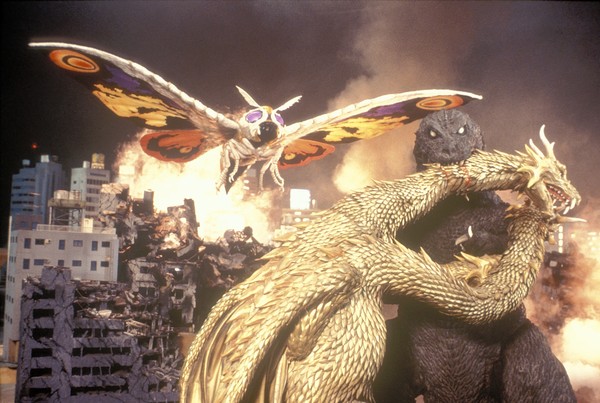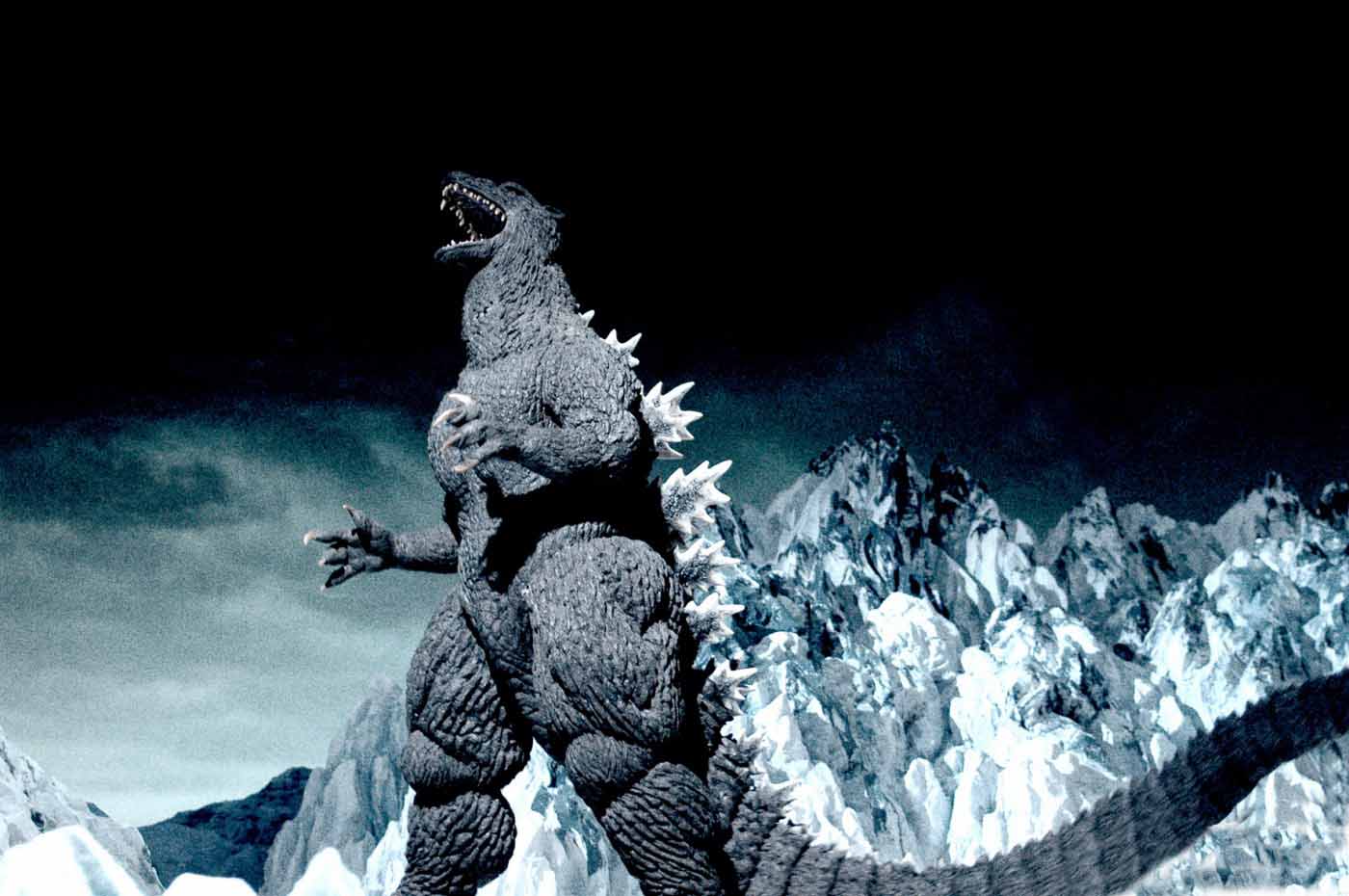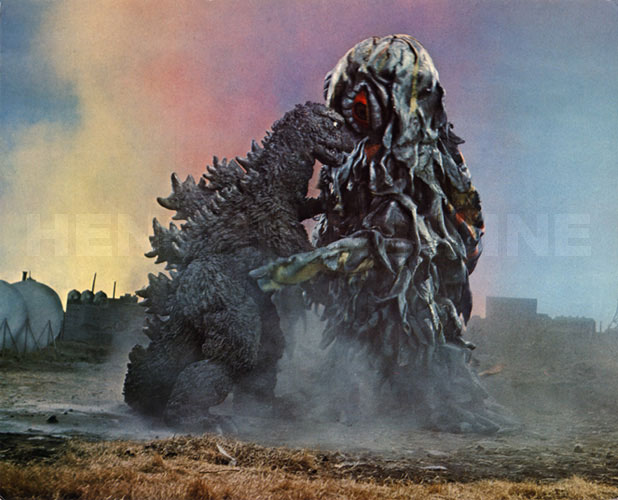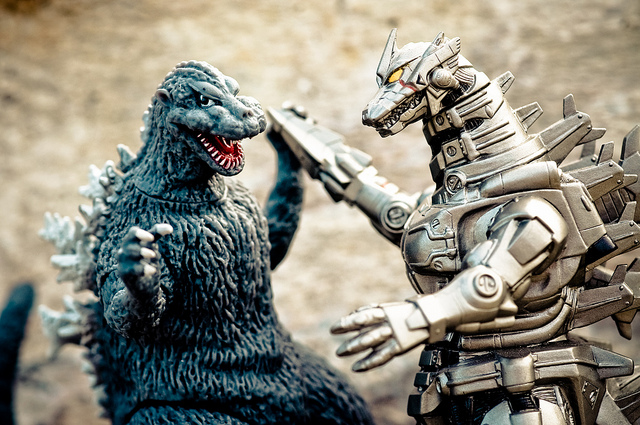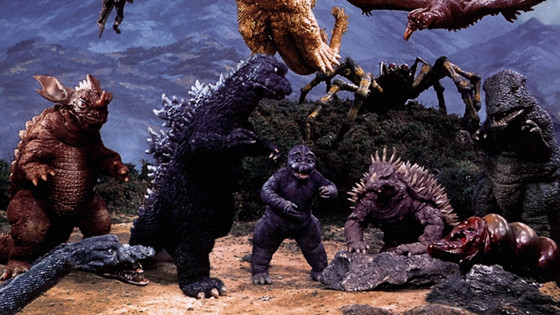Now that the Godzilla reboot is raking in serious money at the box office, some of you out there may be wondering just where else to go to get your Godzilla fix. After all, we’re talking about a character who’s been around for more than half a century now, and there’s something on the order of thirty movies to chose from. If you’re not obsessive-compulsive enough to watch them all, you might be at a loss as to which ones to choose from. Are they all good? Well, no, although there’s no small number of G-Fans who would tell you otherwise (the 1998 Dean Devlin/Roland Emmerich version being a glaring exception—nobody likes that movie). If only there were some way to know which ones are most worth the investment of your time…
You’ve come to the right place, my friend! The list you are about to peruse lays out what I consider to be the ten strongest G-films in the long-running, near-to-immortal series. There are those who will take exception with some of the choices I’ve made here, and while I’m as quick to respect the opinions of others as the next person, I firmly believe the films I’ve compiled here represent the best of the series, and serve to demonstrate why a gigantic, radioactive dinosaur has continued to be an internationally recognized, beloved, and successful movie character for sixty years.
You’ll notice that I’ve picked mostly from the Showa series (the films that appeared from 1954 to 1975, after which the series was put on a decade-long hiatus), only taken one from the Heisei series ( 1984-1995, which was far weaker than the series that proceeded it and, in my opinion, produced only one truly memorable film) and two from the Millenium series (1999-2004, for the same reason). I feel it’s important to focus on those films that served as highpoints, that kept the series in the public eye and came to define what most people think of as a “Godzilla movie”. There have been many different approaches, not to mention shifts in tone, but in the end they all come down to one thing: the King of the Monsters almost always wins.
10. Godzilla, Mothra and King Ghidorah: Giant Monsters All-Out Attack
I have some issues with the Millenium Series of Godzilla movies: they have the annoying habit of rebooting the character from film to film, each one insisting that Godzilla’s appearance is the first one since his initial rampage in 1954 (the one exception being Godzilla: Tokyo SOS). Also, they tend to lack some of the sense of fun of the Showa Series or even some of the Heisei Series pictures.
This is one of two that, for me, comes closest to recreating a bit of the campy, quirky element that made the earlier films so special. What’s odd is that it comes wrapped in kind of a semi-pompous origin for this new Godzilla: rather than just be a mutated radioactive beast that stomps buildings and breathes energy beams, Godzilla is also the living embodiment of all the Japanese dead from World War II. That’s a little heavy for a suitmation monster movie, but I suppose after so much time director Shusuke Kaneko felt it might be good to throw something fresh into the mix.
Mysticism and monsters are kind of his thing, after all; he’s also the man who brought us the ’90’s Gamera series, praised by many as some of the best kaiju films of all time. While that may or may not be the case, he definitely has a deft hand when it comes to shooting complicated monster effects, and his Godzilla is one of the most menacing of the post-2000 series. As with the Gamera films, his fights have a crazy energy that helps to keep things rolling.
Interestingly, King Ghidorah is a good guy in this movie, fighting alongside Mothra and Baragon as one of Earth’s intrepid defenders against the rampaging Godzilla, who is fully a bad guy here. I’m not sure how I feel about that—overall, Ghidorah makes a much more convincing villain, and it always seems more fun to see Godzilla’s alliances shift according to his mercurial mood. But don’t let any of that keep you from watching this entertaining installment in the series.
9. Godzilla: Final Wars
I imagine when director Ryuhei Kitsmura (who helmed the incredible yakuza-fight-zombies film Versus) was approached with this project, he took a few moments to consider what makes a really great Godzilla film. Suitmation? Absolutely. A ton of weird monsters? There’s no need to ask. Batshit lunacy? (insert image of scraggly-haired man in straight jacket babbling to himself and nodding furiously)
Final Wars was clearly intended to be campy, over-the-top, ridiculous and mindlessly entertaining. Even after watching it for the first time, I wasn’t entirely certain what it was about, and I didn’t care. Again we have sinister aliens who want to take over the world, and again they use freakishly huge monsters to effect their plans. They wear leather trenchcoats and look like members of a gothy Duran Duran tribute band. There is a bunch of Matrix-style wire-fu fighting. A roster of well-known monsters line up to fight Godzilla, who has to take them all on pretty much by himself.
There’s a distinctive Destroy All Monsters vibe here, and that seems appropriate because this is the last Japanese Godzilla production to date. As with that film, there’s the feeling of it being a last hurrah, and the filmmakers want to throw just about everything they have at you. The monster fights are a return to the classic comic absurdity of the Showa era, with Big G at one point taking on a robotic Ghidorah and a chainsaw-handed Gigan (with a little help from Mothra). And most hilariously (or stupidly, depending on you point of view), he makes short work of the Godzilla from the 1998 American remake—a small gesture I like to think of as Toho telling the American studios “Yeah, thanks for nothin’”.
8. Godzilla Vs. Hedorah aka Godzilla Vs. The Smog Monster
Of all the Godzilla movies produced in the 1970s, this is the one that feels the most Seventies in spirit, owing to its overt anti-pollution, pro-environmental message for kids. Director Yoshimitsu Banno even includes an animated sequence demonstrating the effect of pollution on the quality of life in Japan, and showing a bit of the life cycle of Godzilla’s extraterrestrial foe, transformed by waste and garbage into a shambling, shapeless mound with eyes.
This one was a bit of a departure from other films at this point in the series. For one thing, Godzilla only fights one monster, a fact that is mitigated to some degree by its tendency to assume different forms, going from a swimming tadpole-like creature that Big G easily vanquishes to a massive upright horror that also has the power to take to the air. It also shows Godzilla at his most “good guy”, presenting him as an unambiguous hero for the world to root for. The director also decided to give Godzilla the ability to fly, which he does by blasting his atomic breath like a jet propulsion engine and hurtling through the air backwards.
Opinions are understandably divided as to the quality of this entry, but I have to confess to a certain fondness for it. It stands on its own in terms of almost every choice for what appears onscreen, especially during the weird finale where Godzilla gleefully tears a defeated Hedorah to pieces like a four-year-old attacking a fallen piñata. Oddly surreal, and worth a look for anyone curious to see the strangest phase of the franchise.
7. Godzilla Vs. Mechagodzilla
Apart from Ghidorah, Mechagodzilla was the villain who turned up the most often over the years to hassle our energy beam-breathing friend. After this film came Terror of Mechagodzilla in 1975, then a very long hiatus, at the end of which Godzilla’s robot analogue came back no fewer than three times—unfortunately in some of the least noteworthy entries in the series. But here the metal monster is shown in all its finger-missile glory, arriving in the guise of the real Godzilla in order to rain down destruction on the orders of yet another hostile band of alien invaders—who are ape-men this time, instead of giant cockroaches or Rayband-wearing weirdos.
You can really sense the change in tone in terms of what was considered allowable onscreen in a film that was ostensibly marketed to children. During Mechagodzilla’s first appearance, in which he fights Godzilla’s ally Anguirus, he very brutally attempts to tear the other monster’s jaw from his head. Later, Godzilla receives several bloody wounds—including a brief appearance of Lone Wolf and Cub-style arterial bloodspray—in his grim final battle with his mechanized foe. This is a marked change in style from earlier films, which focused much more on the giant monster variant of pro wrestling.
The increased violence very likely reflects the cinematic mores of the time (after Peckinpah’s The Wild Bunch, bright red blood was all the rage in the movies), but its not the only thing to make its debut—much like Superman, Godzilla occasionally trots out new powers he never thought to use before, in this instance the ability to magnetize himself and cause all nearby metal objects to stick to his skin, very convenient when taking on an opponent made entirely out of metal whose head you need to rip off.
6. Destroy All Monsters
As with all sequels, it was probably inevitable that Toho would reach this point of escalation. One can picture a Toho executive strolling around the lot one day and wandering into a storage area jammed with rubber monster suits. “Man, that’s a lot of monsters,” he thinks. “I wonder if we can pack them all into one movie?”
Destroy All Monsters is the movie that answers that question, and the answer is yes. Short of Toho’s King Kong, just about every lumbering behemoth that had ever made an appearance in a Godzilla film shows up in this one, and then some. Once again, extraterrestrials are to blame for the monster shenanigans, which start when various beasts escape from Monster Island (or Monsterland, if you want to be pedantic about it) and attack different major cities worldwide.
Along with Godzilla, Rodan and Mothra you also have Godzilla’s son Minilla, Gorosaurus, Ghidorah, a giant spider named Kumonga, the spiny-backed Anguirus, Manda and Baragon. Varan the Unbelievable even turns up, and I don’t think he ever appeared in anything other than this after his solo film from the ’50’s.
There isn’t a whole lot to say for Destroy All Monsters except that it recycles part of the plot of Invasion of Astro-Monster and throws everything it has at you, accounting in large part for the enduring popularity of this entry. The go-for-broke feel of the production owes a lot to the fact that it was intended by the studio to be the very last Godzilla movie, a notion that seems kind of naïve in retrospect. I’m sure ticket sales induced studio heads to think, “You know what? Let’s just keep making these.”
Unlike any Godzilla movie I can think of before it, the story is set in the distant future of the late 20th Century (don’t you remember back in ’99 when huge monsters attacked every city in the world? I lost all my System Of A Down CDs), further adding to the “This is the very last one we’re gonna do” vibe of the film. Not the strongest of the lot by any means, but a hell of a lot of fun anyway.

